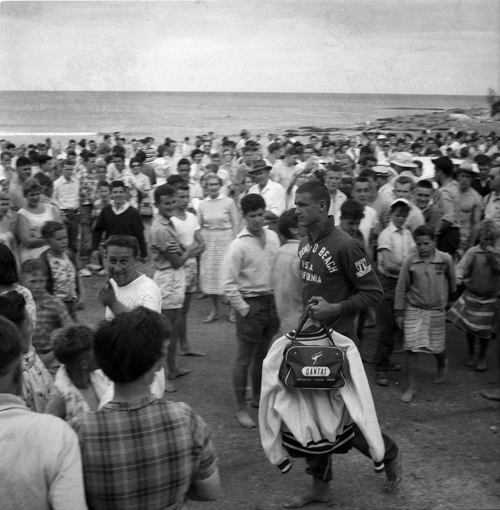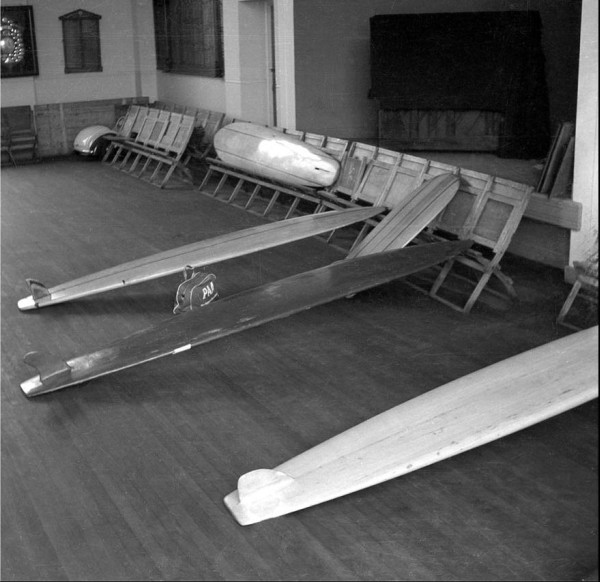The US Olympic team visits Cronulla in '56
 History, as the saying goes, is an unfolding story. As time rolls on new perspectives and contexts are added to old events. They're looked upon in new ways, through different filters, and in this way the same tale can be told but with added richness and detail.
History, as the saying goes, is an unfolding story. As time rolls on new perspectives and contexts are added to old events. They're looked upon in new ways, through different filters, and in this way the same tale can be told but with added richness and detail.
But it's not the only way the historical record is added to.
Some events are simply overlooked, left off the historical record for various reasons, and the detail is not one of perspective or context but an empirical matter of fact. Such an event happened at Cronulla in 1956 and it's the focus of a talk being held there this weekend.
In 1956 Australia hosted its first Olympic games, held in Melbourne. Surf Lifesaving was an exhibition sport that year and the American's fielded a team that included upcoming big wave rider Greg Noll and established paddle board and surfing champion Tommy Zahn. However it wasn't the new rescue techniques nor lifesaving equipment that caught the Australian's eye but rather their recreational equipment – lightweight modern surfboards – and how the Americans rode them – angling toward the beach on the open face.
The Americans were invited to hold a couple of exhibitions riding these boards – nicknamed Malibu chips, and later just malibus by Australians – first at Avalon in Sydney and then at Torquay just prior to the beginning of the Olympic games.
En route to Torquay the party took a short day-long detour to Cronulla and it is this event that has been largely overlooked by the history keepers. It doesn't rate a mention in Matt Warshaw's otherwise exhaustive reference book, 'The History of Surfing'. Cronulla surfers present on that day had little understanding of the significance of the visit nor the huge changes the sport would soon undergo as a direct result. The photos, however, tell part of the story.
In one of the few photos from the day the American team appear almost alien-like amongst the Aussie crowd. While the hosts wear dark suits and hats, the US team are dressed casually in matching team jackets, have their hair slicked back in what would become the quintessential beach look, and they also appear to tower over their hosts. The latter point is an illusion, Zahn measuerd just 5'10” but it's his straight-backed confidence juxtaposed against the Australian's clear sense of awe that gives him stature.
 Then of course were the boards, measuring just 10 feet long and made of foam and fibreglass, a relatively new material made popular during America's WW2 effort. Although they were dismissed by some Australians – Greg Noll recalls a local rapping his knuckles on his board saying “Give you two bob for the works, mate.” His way of saying the boards were worthless – their performance in the water couldn't be ignored.
Then of course were the boards, measuring just 10 feet long and made of foam and fibreglass, a relatively new material made popular during America's WW2 effort. Although they were dismissed by some Australians – Greg Noll recalls a local rapping his knuckles on his board saying “Give you two bob for the works, mate.” His way of saying the boards were worthless – their performance in the water couldn't be ignored.
At Cronulla Point the locals, according to Jon Salmon who was there on the day, "sat much further out on the wave. We were running a good 100 metres on the green swell." Meanwhile the Americans, "were further in and they would watch us come through before they got on the wave. We saw them cracking waves and we couldn't believe their dexterity."
The response of Cronulla surfers was similar to their countrymen in Avalon and Torquay who also witnessed those first displays of malibu riding. They were bewildered by the manoeuvrability of the new lightweight boards. Said Jon Salmon, "They [the Americans] were treated like royalty and it was a very big deal...a very big event for us."
In one afternoon Cronulla surfers were exposed to an appealing new culture, new materials and constructions method, and a whole new way of riding waves. Things were never the same on the beaches.
This Saturday afternoon at Cronulla SLSC I'll be chairing a talk with four of the young surfers present that day – Barry Regan, Brian Jackson, Gary Birdsall, and Jon Salmon. Everyone is welcome to attend as we discuss the detail and the consequences of this historical day.


Comments
This was the birth of modern Australian surfing and in terms of influence is far more significant than Duke's visit. There are two dimensions to this. The first is the obvious one of the huge step forward in performance. The second is the cultural impact triggered by lightweight boards that didn't need to be stored at the surf club and so broke surfing free from the surf clubs. Combined with the youth culture being simultaneously imported from US, this was our true beginning.
In the history of Aus surfing, a curious part of the story is Hollywood actor Peter Lawford possibly bringing the first fibreglass surfboard to Australia.
Lawford, centre, in the 'pit' at Malibu.
True, he left it at Bondi SLSC where it was dismissed by the locals who took it for a ride. They just weren't interested in riding waves that way. They had to be shown the whole package - style, comportment, attitude, and of course how to correctly ride a malibu chip - before they were won over.
There was the weekend at Freshwater SLSC celebrating the Duke's and Freshwater's contribution to Australian Surfing.
Now this session at Cronulla SLSC celebrates the 1956 US Olympic team and Cronulla's contribution to Australian surfing.
Maybe there should be a third event. A weekend at Bondi SLSC celebrating Peter Lawford's gift of Australia's first fibreglass board, and where Bondi can apologise to the Australian nation for letting us all down. I'd so go to that. :)